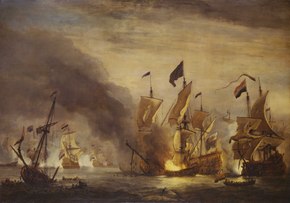Fire ship

A fire ship or fireship is a large wooden vessel set on fire to be used against enemy ships during a
Hellburners, also called "explosion ships", were a variation on the fire ship, intended to cause damage by blowing up in proximity to enemy ships.
Fireships were used to great effect by the outgunned English fleet against the Spanish Armada during the Battle of Gravelines,[1]: 7–11 the Dutch in the raid on the Medway, Chinese warlord Sun Quan in the Battle of Red Cliffs,[2] and the Greeks in their war of independence.
History
Ancient era, first uses

The Tyrians launched a fire ship that destroyed two Macedonian siege towers and other siege engines at the Siege of Tyre (332 BC).
Carthaginian fire ships destroyed many Roman vessels and came close to burning the entire Roman fleet in a battle in 149 BC during the Third Punic War.
In
's naval forces with a fire ship filled with bundles of kindling, dry reeds, and fatty oil.Fire ships were employed to decisive effect by the
The invention of Greek fire in 673 increased the use of fire ships, at first by the Greeks and afterward by other nations as they came into possession of the secret of manufacturing this substance. In 951 and again in 953 Russian fleets narrowly escaped destruction by fire ships.[citation needed]
Age of fighting sail, refinement
This section needs additional citations for verification. (February 2021) |

While fire ships were used in the Medieval period, notably during the
While only used sparingly during the
Warships of the
The role of incendiary vessels changed throughout the age of the modern fire ship. The systematic use of fire ships as part of naval actions peaked around the
Use in the Greek War of Independence


In the
19th and 20th centuries, obsolescence
From the beginning of the 19th century, steam propulsion and the use of iron, rather than wood, in shipbuilding gradually came into use, making fire ships less of a threat.[citation needed]
During the
During
The successful
21st century, revival with kamikaze USVs
In October 2022, during the
Notable uses
This section needs additional citations for verification. (February 2021) |
Notable fire ship attacks include:
- Huang Gai's attack on Cao Cao at the Battle of Red Cliffs.[2]
- Alexander the Great's Siege of Tyre in 332 BC. The Tyrians used the fire ship in attempt to destroy Alexander's mole.[12]
- Syracuse in their battle with the Athenian fleet.
- Battle of Cap Bonin 468.
- Battle of San Juan de Ulúa in 1568. John Hawkins' flagship Jesus of Lübeck was attacked by a fire ship before being stormed by Spanish seamen.
- Siege of Antwerpin 1585. Both fire ships and exploding vessels were employed together for the first time.
- Francis Drake's attack on the Spanish Armada moored at Gravelines in 1588. The fire ships did no damage, but the Spanish scattered in panic and were easy prey for English ships.[1]
- Maarten Tromp's attack on the Spanish fleet moored off the Kent coast in the Battle of the Downs in 1639. The Spanish fleet was destroyed.
- Joint attack from the Swedish and Dutch fleets against the Danish fleet at the Battle of Fehmarn in 1644. Two Swedish fire ships were used (Lilla Delfin and Meerman) and one Danish capital ship exploded. The battle was a decisive Swedish and Dutch victory.
- Dutch Raid on the Medway in 1667, with 12 available fireships (8 actually used).
- Michiel de Ruyter's attack on the anchored English fleet at the battle of Solebay in 1672 in which HMS Royal James was burned, killing Vice-Admiral Edward Montagu, 1st Earl of Sandwich, and wounding Royal James's captain, Richard Haddock.[1]: 14–16
- Destruction of 15 French ships of the line, including Battle of La Hougue.[1]: 16–18
- Russian attack on the Ottoman fleet at the Battle of Chesma in 1770.
- US attack on Tripoli during the First Barbary War in 1804 by USS Intrepid.
- Thomas Cochrane's attack on the French in the Battle of the Basque Roads in 1809.
- ships of the line during the Greek War of Independence.
See also
- List of fireships of the Royal Navy
- MT explosive motor boat
- Burning of the Ottoman flagship off Chios
- Operation Lucid
- Shin'yō-class suicide motorboat
References
- ^ a b c d e f g h i j Coggeshall, James (1997). The Fireship and its Role in the Royal Navy (PDF) (Thesis). Texas A&M University – via nautarch.tamu.edu.
- ^ a b de Crespigny, Rafe (1969). The Last of the Han: being the chronicle of the years 181–220 AD as recorded in chapters 58–68 of the Tzu-chih t'ung-chien of Ssu-ma Kuang. Canberra: Australian National University, Centre of Oriental Studies..
- ^ Brewer, David (2003). The Greek War of Independence: The Struggle for Freedom from Ottoman Oppression and the Birth of the Modern Greek Nation. Overlook Press. p 93.
- ^ Anderson, Roger C. Naval Wars in the Levant 1559–1853. Princeton University Press. pp. 487–488.
- ^ ISBN 9780307744678. Retrieved 6 March 2017.
- ISBN 9780842028684. Retrieved 6 March 2017.
- ^ Kindell, Don. "Battle of Britain, September 1940". naval-history.net. Retrieved December 20, 2023.
- ISBN 1-86176-057-4.
- ISBN 0-313-28797-X.
- ^ Helmer, Kendra (27 April 2004). "Suicide bombing attack claims first Coast Guardsman since Vietnam War". Stars and Stripes. Retrieved December 20, 2023.
- ^ Chinnock, E. J. (1893). "18. Siege of Tyre - Construction of a Mole from the Mainland to an Island". Life and Writings of Arrian. Archived from the original on May 2, 2005. Retrieved December 20, 2023 – via websfor.org.
External links
![]() Media related to Fire ships at Wikimedia Commons
Media related to Fire ships at Wikimedia Commons

